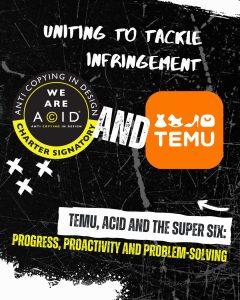

Timeless Design Rooted in Mid-Century Style & IP Confidence
Inspired by a deep love for mid-century design, music and architecture, designer Gail Myerscough creates products that are both nostalgic and contemporary, standing apart from fast-moving trends. Her collections are thoughtfully crafted in the UK using sustainable practices and high-quality materials, with a focus on lasting design over throwaway culture. As a freelance designer navigating an ever-evolving digital marketplace, Gail relies on her Anti Copying In Design (ACID) membership to safeguard her creative work through documentation, the ACID IP Databank and design protection. Discover how Gail brings Blackburn’s history to life in her work—while ensuring her intellectual property (IP) is protected every step of the way.
Can you tell us about the inspiration behind your brand and what makes you innovative in the market?
My brand is inspired by a lifelong passion for mid-century design, music and architecture. I create designs that evoke a sense of nostalgia but with a modern contemporary feel. In a market that often follows trends, I stay true to my aesthetic, ensuring my designs feel timeless.
What steps do you take to ensure that your products are designed with sustainability and quality in mind?
My products are made by carefully selected manufacturers in the UK. My manufacturers are committed to being as sustainable as possible. Where possible I use recycled materials, and I keep my packaging minimal and plastic free. In a throwaway culture a big part of my brand is designing quality products that are made to last.
Have you faced any challenges with copying or infringement of your designs, and how have you addressed these issues?
My work has probably been copied but I haven’t come across it yet. I document my designs but joining ACID helps me to protect my designs. In a world of AI and TEMU it feels more important than ever to protect my designs.
What motivated you to join ACID, and how do you see ACID membership benefitting your brand?
I joined ACIDto help me protect my designs and it helps to feel part of a supportive community. If an issue arises, I feel more confident knowing I have support and advice to hand. I feel that having the ACID logo on my website and email signature will give my clients and customers confidence in the originality of my work.
Have you brought anything new to the marketplace recently that you would like to share?
I have recently created a series of designs based on my hometown of Blackburn in Lancashire. Blackburn Shopping Centre was opened in 1967 and was one of the earliest and most radical town centre redevelopment schemes. The result was praised at the time by critics such as Ian Nairn but most of the original design has been lost. My designs are the Blackburn of my youth.
Are there any specific steps you take to protect your IP rights? For example, do you use or rely on trade marks, legal agreements, design rights, registered or unregistered?
Since joining ACID I have been putting my designs in the ACID IP Databank. Everything I create is dated and documented. For collaborations and licensing work I always read contracts very carefully before I sign anything. I keep a file of all my contracts in date order.
What advice would you offer to a new designer?
It’s important to find your unique voice. This is what will set you apart. Make sure you document everything you create and become familiar with contracts and agreements. It’s important to be a part of something like ACID so you feel like you have support. Being a freelance designer can be lonely so build those connections.
ACID values the support of its members to enable it to campaign for design law reform. Do you have any messages for Government/Policy Makers on IP issues? Do you think that copying of designs is deliberate and blatant?
Copying can be blatant. It’s disheartening how large companies think that it’s ok to take designs from independent designers, often without consequences. It’s so important to have proof of your designs if this arises. I wish design was given the same importance as other forms of IP. Creativity drives so much of our economy, and it deserves proper protection.
Have you signed the ACID IP Charter?
Yes, I’ve signed the ACID IP Charter. I fully support its mission to protect original design.






Spread the Word

Latest News

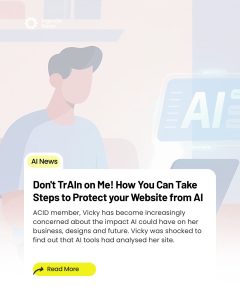
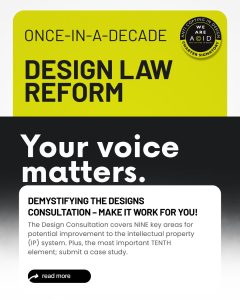
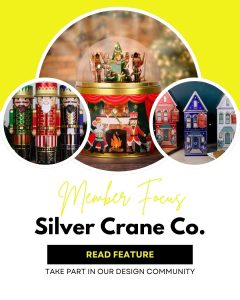
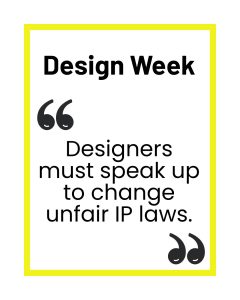
Newsletter Sign-Up
| Cookie | Duration | Description |
|---|---|---|
| cookielawinfo-checkbox-analytics | 11 months | This cookie is set by GDPR Cookie Consent plugin. The cookie is used to store the user consent for the cookies in the category "Analytics". |
| cookielawinfo-checkbox-functional | 11 months | The cookie is set by GDPR cookie consent to record the user consent for the cookies in the category "Functional". |
| cookielawinfo-checkbox-necessary | 11 months | This cookie is set by GDPR Cookie Consent plugin. The cookies is used to store the user consent for the cookies in the category "Necessary". |
| cookielawinfo-checkbox-others | 11 months | This cookie is set by GDPR Cookie Consent plugin. The cookie is used to store the user consent for the cookies in the category "Other. |
| cookielawinfo-checkbox-performance | 11 months | This cookie is set by GDPR Cookie Consent plugin. The cookie is used to store the user consent for the cookies in the category "Performance". |
| viewed_cookie_policy | 11 months | The cookie is set by the GDPR Cookie Consent plugin and is used to store whether or not user has consented to the use of cookies. It does not store any personal data. |